|
|
|
|
THE MYSTICAL ARK of HUGH of ST. VICTOR
PL images: 176 1007-1010
To prepare for lectures he gave about 880 years ago, Hugh of Saint Victor painted an extraordinarily intricate, multi-color teaching aid on the wall of the Abbey of Saint Victor in Paris. The painting was probably about 4 meters tall and 4.5 meters wide. It was “the most complex single work of figural art from the entire Middle Ages.” Called the Mystic Ark, it placed a neo-platonic macro/microcosm into a God-centered understanding of creation. Unfortunately, neither the painting nor any copy or drawing of it has survived.
However, one of Hugh's students wrote a 42-page verbal description of the Mystic Ark painting. That description is a dull, matter-of-fact, non-literary text with "bare, utilitarian, even hurried description." It is not effectively organized, step-by-step instructions for duplicating the Mystic Ark. It contains no illuminations or drawings of any parts or aspects of the painting. Verbal descriptions of paintings were apparently so little valued in the Middle Ages that no other such descriptions longer than a single sentence has survived. Nonetheless, the student's verbal description of the Mystic Ark became a highly popular text by medieval standards. Eight-eight manuscripts of it have survived across nearly nine centuries to the present.
With years of research and painstaking effort, Conrad Rudolph, professor of medieval art history at the University of California, Riverside, has visually reconstructed the Mystic Ark. Rudolph synthesized the textual description with relevant images that have survived from the period, place, and culture of the text:
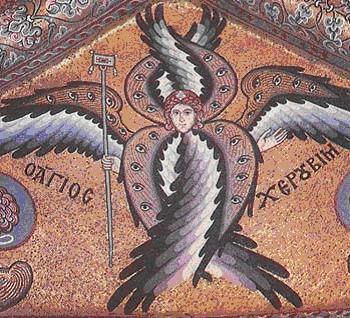 |
 |
SIX-WINGED SERAPHIM
Medieval Representation of the Cherub and the Diagram in Beinecke MS 416 By: Brian Noell
[The Cherub (sic “Seraph”) in Hugh of St. Victor]
The cherub with six inscribed wings was linked from early in its existence to the teachings of the twelfth-century educator Hugh of St. Victor, particularly his explication of the meaning of Isaiah 6 in De arca Noe morali. Edited by an English Augustinian named Clement, 14 Hugh’s discussion of the seraphim appears as early as the latter twelfth-century in a manuscript from the Cistercian monastery of Sawley.15 In this excerpt Hugh asserts that the seraphim represent the two testaments of the scriptures. He asserts that it is possible for man to climb past the chorus of angels and reach the divine presence through the knowledge of them. However, this is only to be done through submitting the seraphim (scriptures) to threefold exegesis. The three pairs of wings represent the three modes of explication:
[1] history,
[2] allegory,
[3] and tropology.
They are in pairs because they lead the spirits of readers to the love of both God and neighbor.
[1] The seraphim cover their bodies with one set of wings. This pair represents historical exegesis, the words and description that introduce the intellect to the actual events of the Bible. It is notable that Hugh departs from the biblical text in describing the disposition of this first pair of wings. Isaiah specifies that the seraphim cover their own faces with one pair of wings and makes no mention of the veiling of their bodies. Hugh conflates Isaiah’s vision with that of Ezekiel, with the result that the seraphim veil their own bodies with one pair of wings. This is similar to visual depictions of Isaiah’s vision in which the seraphim cover their bodies like Ezekiel’s angels and may even suggest that when Hugh was developing his discussion he had such images and not texts in mind.16
[2] The seraphim use one of the wings in their second set to veil God’s head while they cover God’s feet with the other. This disposition represents the allegorical understanding of scripture, by which the mind explores God’s body. In allegorical exegesis the student searches for the ways in which Old Testament history foretells the incarnation of Christ and the formation of the Church. Yet, the covering of the head and feet represent the fact that, in this mode of exegesis, the nature of God’s divinity is not revealed. Neither a beginning nor an end of God can be found. Interestingly, however, Hugh insists that, although the Bible states that the face of God is veiled, he wishes to depict it exposed. Grover Zinn believes that this places the viewer in the position of angel, rising in sanctity to behold the divine vision. Such a state is beyond that of Isaiah’s earthly vision of the Lord enthroned in which the face was veiled.17
[3] The student of the diagram ascends to the vision of the divine with the third pair of seraphic wings. This final set represents tropological exegesis, which the individual uses to exhort others to the study of good conduct. Having engaged in long study of the previous modes and having achieved moral understanding, the spiritual aspirant is finally encouraged to instruct others in what he has learned. He broadcasts what he perceives to be the ethical import of biblical events, yet he does so praising God and not himself. This text, passed down with a number of examples of the image of the cherub with six inscribed wings, stresses both the contemplative and the active elements in devotion. Not only should the student attend to the historical content and allegorical meaning of the Bible, he should also seek to garner moral lessons and to share them with his fellows. It is only in this last phase that the devotee can soar towards the beatific vision that Hugh optimistically believes to be attainable by mortal men.
TREE of VIRTUES/LIFE and MYSTICAL PARADISE
PL images: 176 1007-1010
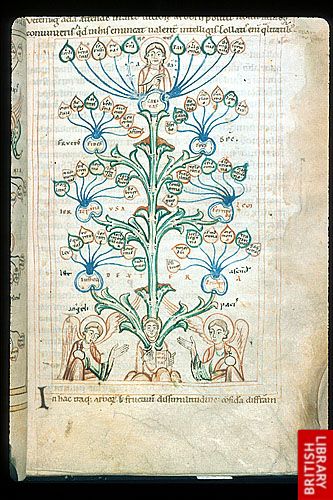 |
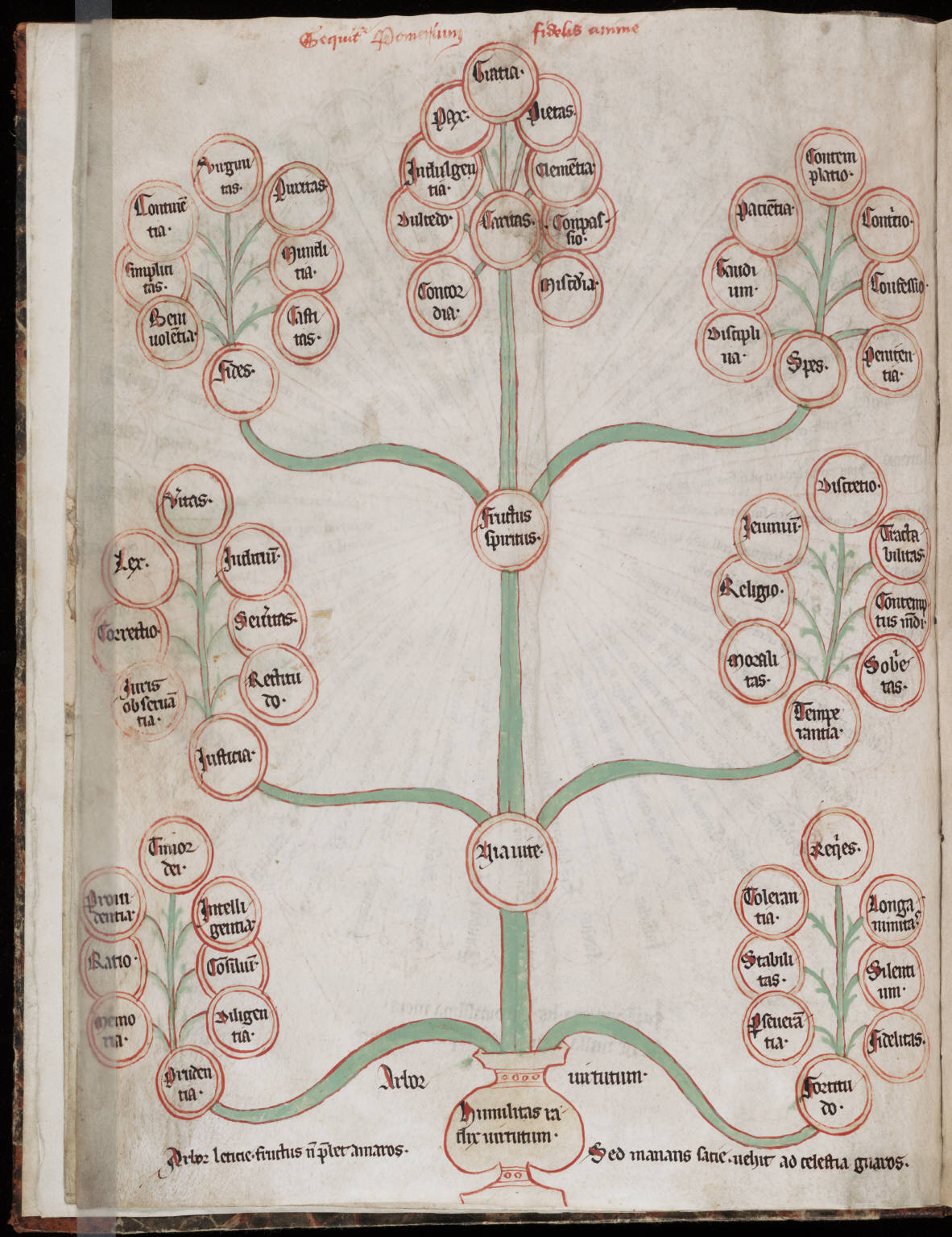 |
PL images: 176 1007-1010
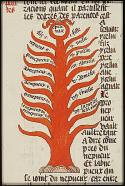 |
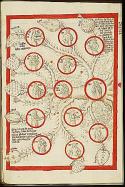 |
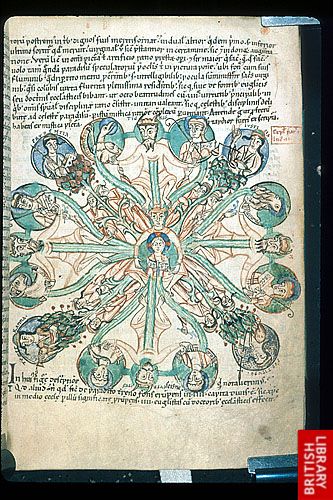 |
This Webpage was created for a workshop held at Saint Andrew's Abbey, Valyermo, California in 1990